
It seems as if Nikon never had great ambitions to build teleconverters and automatic tubes. They introduced their first teleconverters for the F-Mount in 1976, much later than the third-party manufacturers did. Moreover, in contrast to Sigma, Kenko and so on Nikon never offered teleconverters that support the 'screwdriver' AF. Nikon already started with automatic tubes in the 60s. But for more than 25 years there have been no news to report. Especially for the 'G' lenses - Nikon's default lens interface for more than ten years now - there are no tubes available!
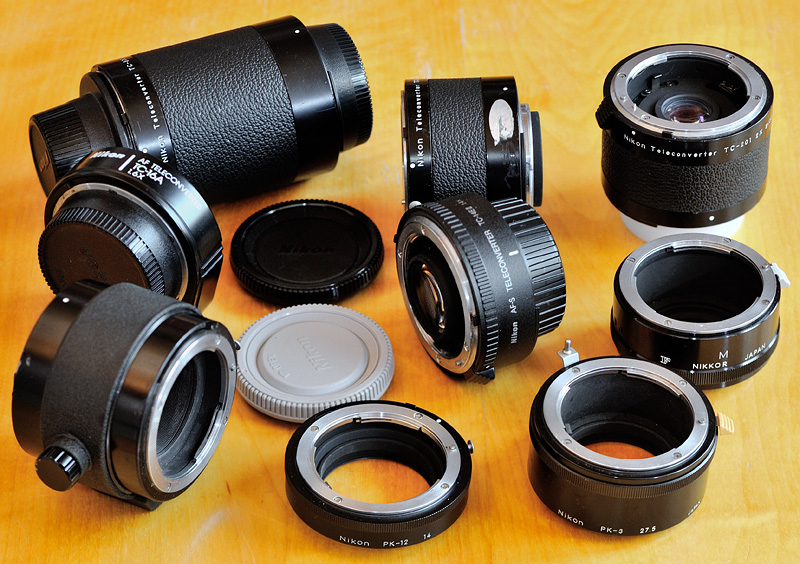
|
|
Group photo: some of the tubes and teleconverters Nikon has produced over the years. |
|
|
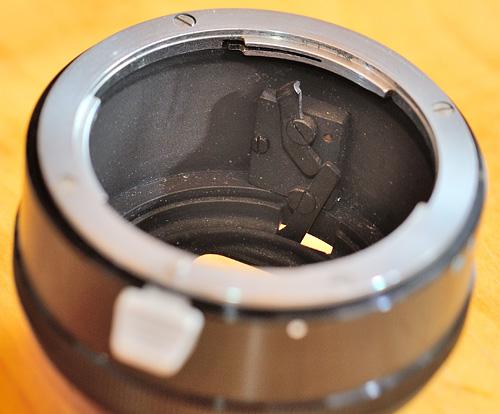
|
|
Aperture lever mechanism of a Nikkor M tube. |
First of all: what does the word 'automatic' mean in this context? An automatic tube has a mechanism that transmits the movement of the camera's aperture lever to the lens, just as if the lens would be directly mounted to the camera body. Thus, the lens will be automatically stopped down to the aperture value you have selected on the lens immediately after you have pressed the shutter release button.
This 'automatic' is fine for focussing. But because the early automatic tubes (Nikon/Nikkor M and M2) had no further coupling, metering had to be done stopped down.
The M and M2 tubes with their extension of 27.5mm were designed for the 55mm Micro-Nikkor in order to enable life size photography (the lens itself goes from infinity down to 1:2, in conjunction with the tube you have the range from 1:2 to 1:1). But of course, these tubes can be used in conjunction with other lenses as well.
The tubes of the second generation have an an old-style coupling shoe and pin to enable open-aperture metering (more information about the old-style coupling technique can be found here). This generation consists of four tubes: Nikon PK-1 (8mm extension), PK-2 (14mm), PK-3 (27.5mm) and PN-1 (52.5mm, with an integrated tripod mount).
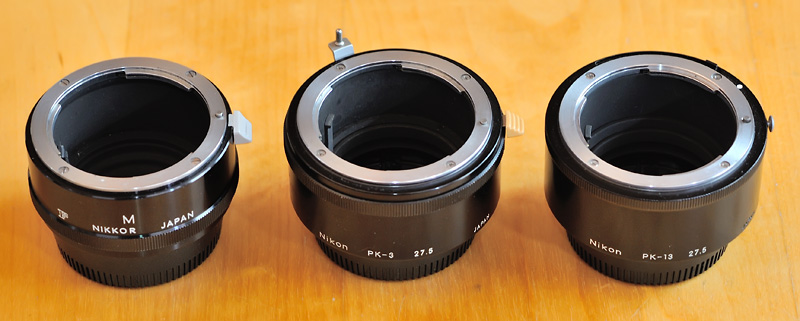
|
|
Three generations of automatic tubes: Nikkor M, Nikon PK-3 and Nikon PK-13. As of October 2013 a fourth generation that supports 'G' lenses is still missing! |
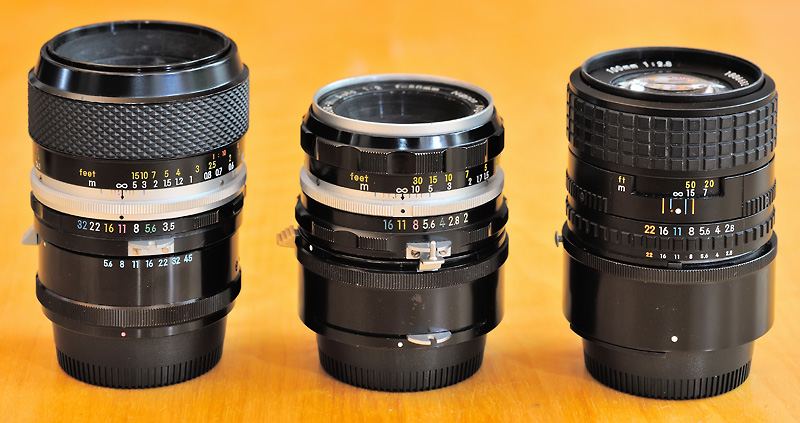
|
|
Exposure metering coupling: none, old-style coupling with shoe and pin, AI coupling. |
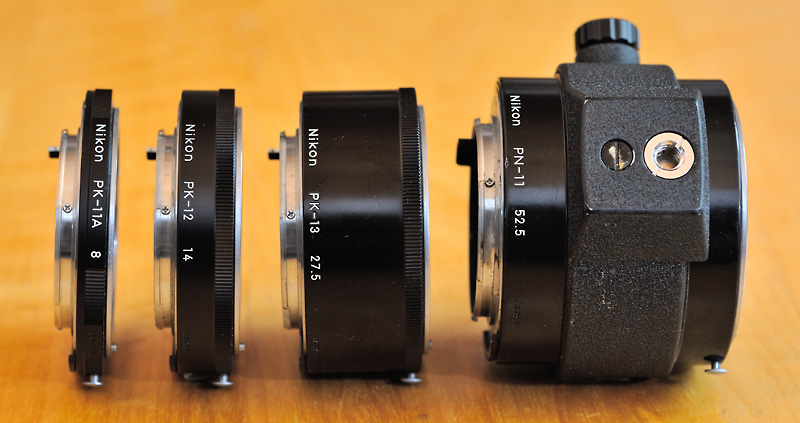
|
|
Nikon's current automatic tube lineup. |
Together with the AI-coupling system Nikon introduced the AI counterparts of the above-mentioned tubes and named them PK-11, PK-12, PK-13 and PN-11. In 1986 (introduction of AF) they replaced the PK-11 with the PK-11A: an AF Nikkor must not be mounted onto the PK-11, while the PK-11A is compatible with many AF Nikkors (BTW: the combination of PK-11A and AF 24mm f/2.8 is marvellous!).
If you need an automatic tube for your DSLR please note: the second generation is not compatible with modern cameras (exceptions prove the rule)! In contrast, the M and M2 tubes are usable, but you have no exposure metering, even if your camera has an AI-interface. Thus, go for the AI versions (but skip the PK-11)!
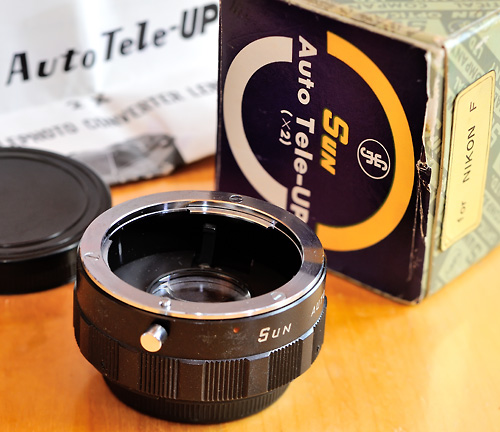
|
|
Early third-party teleconverter (poor perfomance due to only three lens elements). In terms of interface it corresponds to Nikon's early tubes (M and M2). |
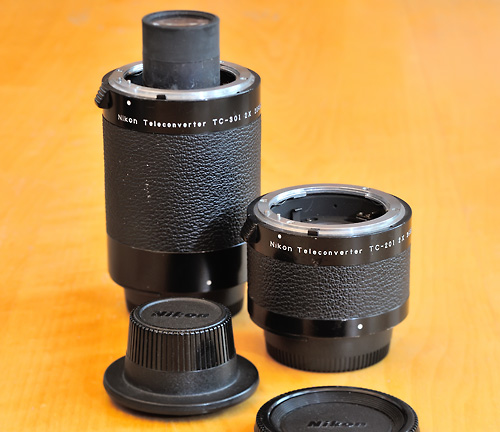
|
|
The two types of 2x converters (shown here the AI-S versions): the left one with its impressive front element is for 300mm and longer, the smaller one is for 300mm and shorter. BTW: for my AF-S Nikkor 300mm f/4 Nikon recommends the usage of the TC-300/301. But in my opinion the TC-200/201 is slightly better optically and much better in terms of handling! |
Nikon introduced their first teleconverters in 1976: two 2x converters, the TC-1 for lenses shorter than or equal to 300mm and the TC-2 for lenses of 300mm and longer. They employ an old-style coupling for metering that matches the one of the second automatic tube generation (with shoe and pin). Due to the upcoming AI technique these early converters were only produced in a relatively small number. Today they are hard to find, I guess most of them can be found on a collector's shelf. Moreover they are mostly useless in conjunction with modern cameras. Skip them!
Shortly after that, AI versions of the two converters came on the market. The TC-200 was the AI version of the TC-1 and the TC-300 was the TC-2's counterpart. By the end of the 70s Nikon announced a 1.4x AI converter for focal lengths of 300mm or longer, the TC-14. These three converters employ the same interface as the above-mentioned tubes of the third generation.
In the 80s Nikon introduced new teleconverters, the AI-S converters. The TC-200 was replaced by the TC-201, the TC-300 by the TC-301 and the TC-14 by the TC-14B. Two additional 1.4x converters joined in: the TC-14A for lenses of 300mm and shorter and the TC-14C that was designed for the Nikkor 300mm f/2 (the TC-14C is extremely rare today, just like the 300mm f/2 itself).
Optically the TC-1, TC-200 and TC-201 are identical, also the TC-2, TC-300 and TC-301 and also the TC-14 and the TC-14B.
In conjunction with a DSLR it does not matter if you are using an AI or an AI-S converter. But please note: AI and AI-S converter does not work with 'G' or 'E' lenses!
Now, let's take a closer look on the interfaces of an AI and an AI-S converter. I recommend to read my articles The difference between an AI-modified and an AI lens and The difference between an AI-S and an AI lens first!
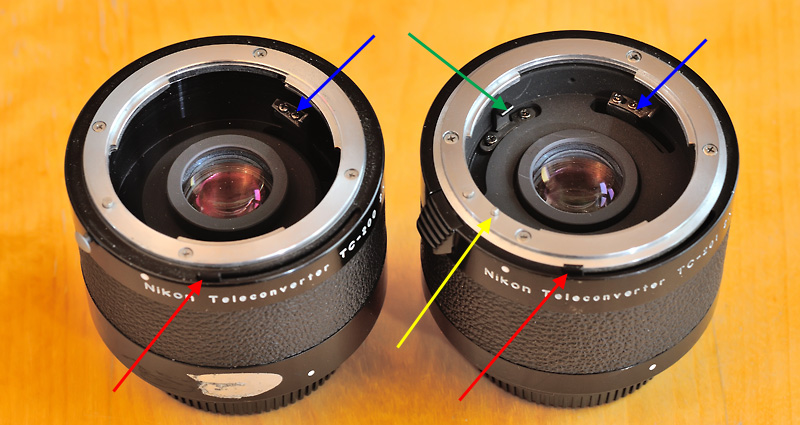
|
|
On the left: the TC-200 AI converter. On the right: the TC-201 AI-S converter. The arrows point to the coupling elements: Blue: aperture lever. Red: AI coupling. Green: lens speed index post. Yellow: AI-S detection. Pink: focal length indicator |
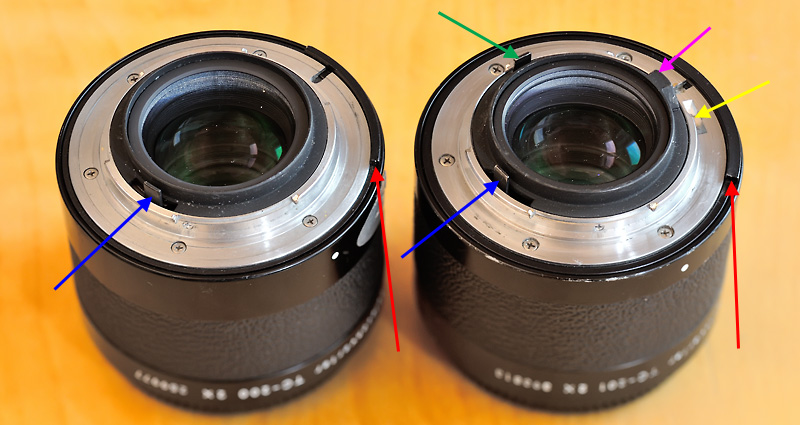
|
Let's begin with the AI-S converter. The name is justified! As you can see the converter has every coupling element of an AI-S lens. Two remarks on that: 1. The focal length indicator is fixed and therefore always signals a focal length of 135mm or longer to the camera. 2. Although a converter decreases the lens speed, the AI-S converter has no conversion in the speed index (e.g. if you have a 105mm f/2.5 on the TC-201, the camera reads a lens speed of f/2.5 and not f/5).
In contrast the AI converter does not behave like a AI lens! It lacks the coupling elements for the lens speed index post but that post is part of an AI lens. Thus, an AI converter behaves like an AI-modified lens. You don't have matrix metering with the F4 or FA!
For both AI and AI-S converters one restriction must be stated: due to the lack of an EE servo coupling post the converters can not be used in conjunction with the F2AS and the DS-12 EE Aperture Control Attachment. I guess you can live with it ;)
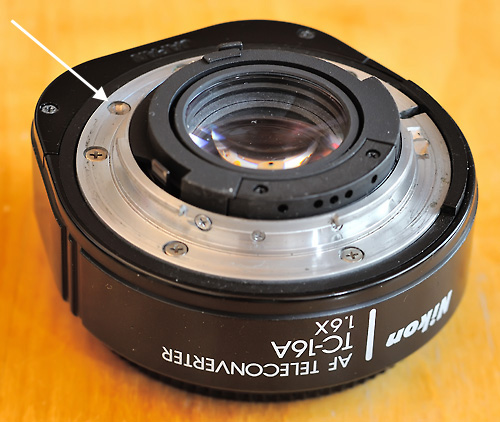
|
|
My TC-16A. I removed the CPU contacts in order to make the converter usable with my DSLRs. The white arrow points to the 'screwdriver' AF coupling. |
In 1983 Nikon introduced their first AF camera for the F-Mount: the F3AF. Together with the camera two AF lenses and the TC-16 1.6x teleconverter were introduced. Have a look at my article AF lenses with an aperture ring.
The TC-16 is a clever tool. The lens system of the converter is focussable. For example an MF 50mm f/1.8 mounted onto the converter makes an AF 80mm f/2.8 on your F3AF. Like the F3AF itself the TC-16 is very rare. Moreover it is almost useless today, only the F3AF and the F4 support this converter. Skip it!
Today more useful is the TC-16A. Optically identical, but based on the 'screwdriver' AF introduced in 1986 with the Nikon F-501 (US: N2020) instead of the AF motor inside the TC-16. This converter is usable with the F-501 (US: N2020), F-801/F-801S (N8008/N8008s), F4 and F90/F90x (N90/N90s). If you remove the CPU contacts like I did (it's easy!) you have an ordinary AI-S converter. 1.6x is a good compromise between 1.4x and 2.0x. And the optical capability is just fine. If you must adjust the internal focus system of the converter you can just do it by simulating AF with a small screwdriver!
Nikon's current generation of teleconverters works with AF-I/AF-S lenses only. The first one was the TC-20E in 1993. As of October 2013 Nikon offers the 2x converter TC-20EIII, the 1.7x TC-17EII and the 1.4x TC-14EII. Each AF-I/AF-S converter has a protruding front element and is therefore especially suitable for longer lenses. All the AF-I/AF-S converters share the same interface.
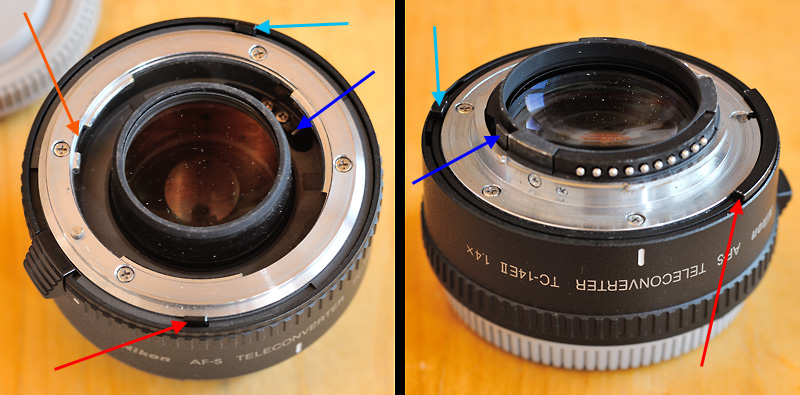
|
|
A detailed view on the TC-14EII's interface. The arrows point the coupling elements: Blue: aperture lever. Red: AI coupling. Cyan: EE servo coupling post. Orange: disconnected flange, only AF-I/AF-S lenses can be mounted. |
Thanks to the AI coupling these converters are backward compatible. If you mount an AF-I or AF-S lens with an aperture ring the converter behaves like an AI converter on a non-CPU camera. My AF-S 300mm f/4 is such a lens and I can use the combination for example in conjunction with my F2AS.
On the other hand, if you mount a lens without an aperture ring ('G' or 'E' type) onto your converter, the combination behaves like a 'G' or 'E' lens and is therefore not usable in conjunction with older cameras (for details see 'G' lenses and 'E' lenses.
Why do these converters have an EE servo coupling post? Does Nikon want to do the owners of an F2AS with a DS-12 EE aperture control attachment a favour? No. The EE servo coupling post has a second function on cameras with a CPU interface only: it gives the camera a signal that the aperture ring of the lens (if existent) is set to the greatest number, see my article Using older lenses on your Nikon DSLR. Because the AF-I/AF-S converters also work on CPU interface only cameras, they must transmit that signal. Besides: in my opinion the post on the camera side of the converter has too much play to properly work with the DS-12!
The disconnected flange in the bayonet mount ensures that only AF-I/AF-S lenses can be mounted. On the Web you'll find instructions for sawing off the smaller part of the disconnected flange. That should make a kind of AI-P converter for lenses other than AF-I/AF-S from your TC. I would not do that because nobody outside Nikon's development department really knows what kind of problems could occur.
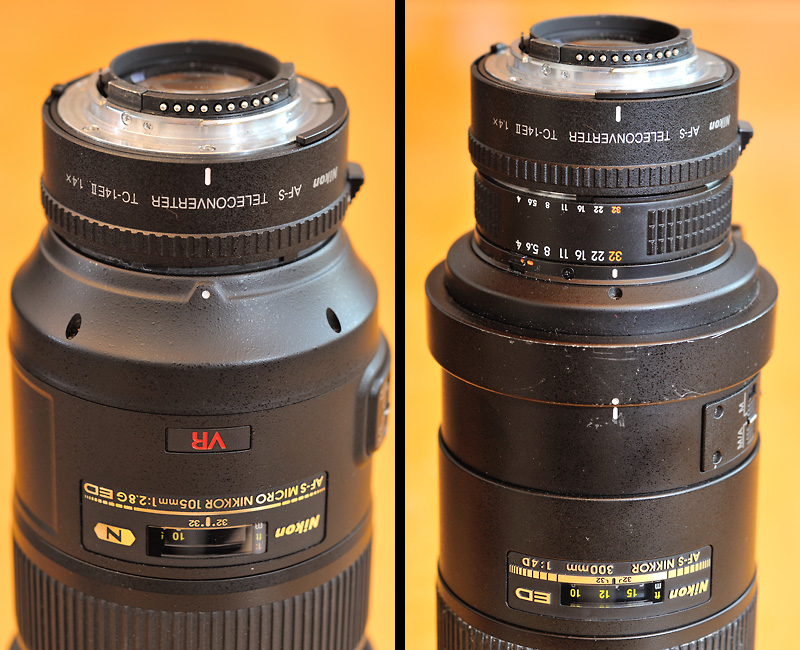
|
|
I use my TC-14EII solely in conjunction with either the AF-S Micro-Nikkor 105mm f/2.8 or the AF-S Nikkor 300mm f/4. Both combinations deliver first class results! |
At last I have to name the TC800-1.25E ED. This 1.25x teleconverter is a supplied accessory of the recently released AF-S Nikkor 800mm f/5.6 E FL ED VR, Nikons first pure 'E' lens. Nikon says the converter must only be used in conjunction with the 800mm E. So I guess this converter has neither an AI coupling nor an aperture lever.